Heterogeneous Fault Mechanisms of the 6 October 2008 MW 6.3 Dangxiong (Tibet) Earthquake Using Interferometric Synthetic Aperture Radar Observations
Abstract
:1. Introduction
2. Methods
2.1. Study Area and Geological Background
2.2. InSAR Observation and Coseismic Deformation
2.3. FEM-Based Inversion
3. Examining the Sensitivity of Coseismic Deformation to Changes in the Topographic Relief, Poisson’s Ratio, and Young’s Modulus
3.1. Effect of Topography on Slip Distribution
3.2. Impact of Heterogeneous Elastic Models on Slip Distribution
4. Results and Discussion
4.1. Inverted Coseismic Slip and Young’s Modulus from a Heterogeneous Elastic Model
4.2. Comparison between Finite Element Models with Different Configurations
4.3. Comparison with Other Slip Models
4.4. Seismogenic Structure Background
4.5. Implications of this Study
5. Conclusions
Acknowledgments
Author Contributions
Conflicts of Interest
Appendix
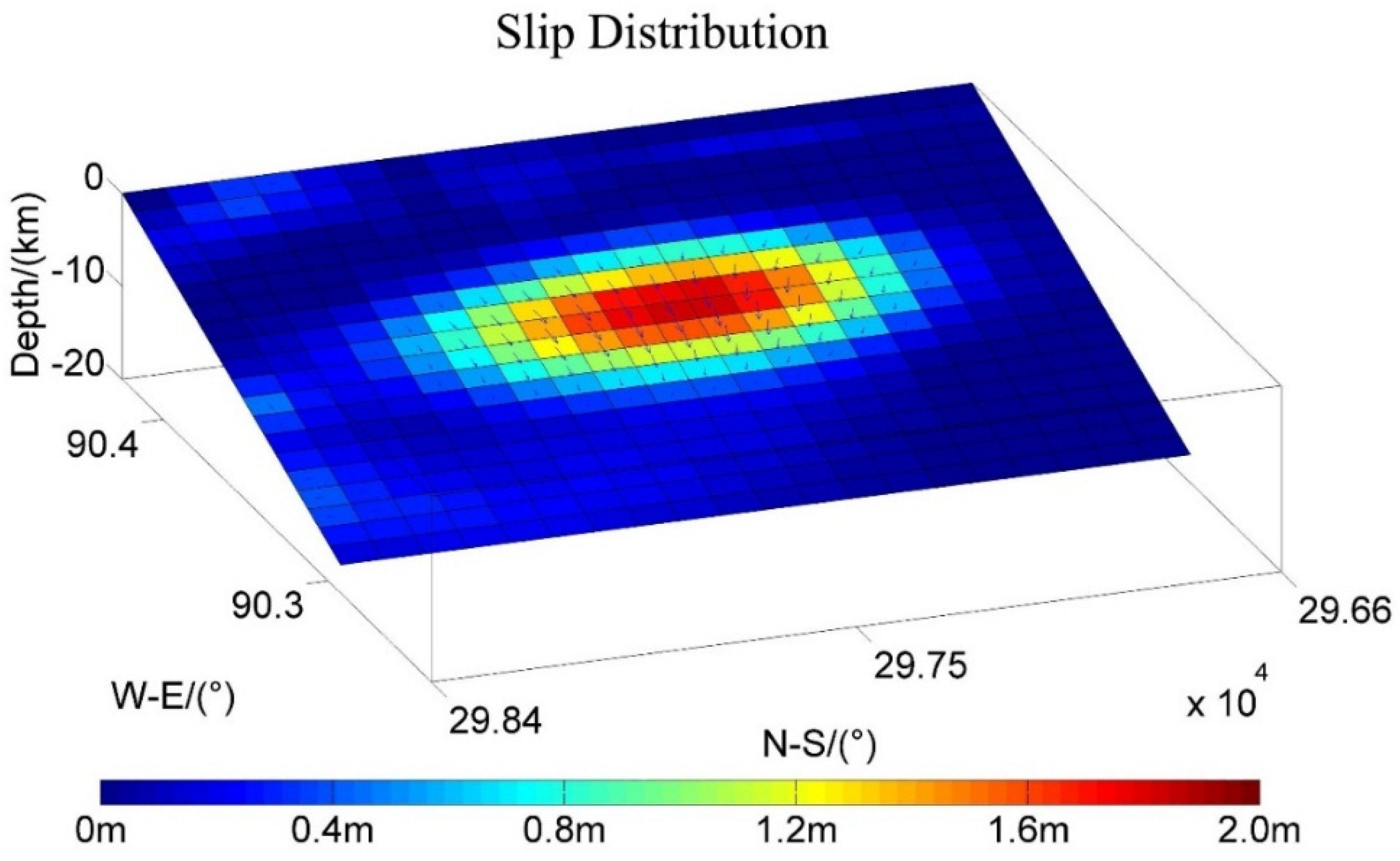
References
- Nikolaidis, R. Observation of Geodetic and Seismic Deformation with the Global Positioning System. Available online: http://sopac.ucsd.edu/input/processing/pubs/nikoThesis.pdf (accessed on 23 October 2015).
- Massonnet, D.; Feigl, K.L. Discrimination of geophysical phenomena in satellite radar interferograms. Geophys. Res. Lett. 1995, 22, 1537–1540. [Google Scholar] [CrossRef]
- Steketee, J.A. On Volterra’s dislocations in a semi-infinite elastic medium. Can. J. Phys. 1958, 36, 192–205. [Google Scholar] [CrossRef]
- Okada, Y. Surface deformation due to shear and tensile faults in a half-space. B Seismol. Soc. Am. 1985, 75, 1135–1154. [Google Scholar]
- Bonafede, M.; Parenti, B.; Rivalta, E. On strike-slip faulting in layered media. Geopys. J. Int. 2002, 149, 698–723. [Google Scholar] [CrossRef]
- Fernández, J.; Yu, T.T.; Rundle, J.B. Horizontal viscoelastic-gravitational displacement due to a rectangular dipping thrust fault in a layered Earth model. J. Geophys. Res. 1996, 101, 13581–13594. [Google Scholar] [CrossRef]
- Megna, A.; Barba, S.; Santini, S.; Dragoni, M. Effects of geological complexities on coseismic displacement: Hints from 2D numerical modelling. Terra Nova 2008, 20, 173–179. [Google Scholar] [CrossRef] [Green Version]
- Zhao, S.; Müller, R.D.; Takahashi, Y.; Kaneda, Y. 3-D finite-element modelling of deformation and stress associated with faulting: Effect of inhomogeneous crustal structures. Geopys. J. Int. 2004, 157, 629–644. [Google Scholar] [CrossRef]
- Williams, C.A.; Wadge, G. An accurate and efficient method for including the effects of topography in three-dimensional elastic models of ground deformation with applications to radar interferometry. J. Geophys. Res. 2000, 105, 8103–8120. [Google Scholar] [CrossRef]
- Bonafede, M.; Rivalta, E. On tensile cracks close to and across the interface between two welded elastic half-spaces. Geopys. J. Int. 1999, 138, 410–434. [Google Scholar] [CrossRef]
- Taira, A.; Saito, S.; Aoike, K.A.N.; Morita, S.; Tokuyama, H.; Suyehiro, K.; Klaus, A. Nature and growth rate of the Northern Izu–Bonin (Ogasawara) arc crust and their implications for continental crust formation. Isl. Arc 1998, 7, 395–407. [Google Scholar] [CrossRef]
- Iwasaki, T.; Kato, W.; Moriya, T.; Hasemi, A.; Umino, N.; Okada, T.; Miyamachi, H. Extensional structure in Northern Honshu Arc as inferred from seismic refraction/wide-angle reflection profiling. Geophys. Res. Lett. 2001, 28, 2329–2332. [Google Scholar] [CrossRef]
- Du, Y.; Segall, P.; Gao, H. Dislocations in inhomogeneous media via a moduli perturbation approach: General formulation and two-dimensional solutions. J. Geophys. Res. Sol. Earth 1994, 99, 13767–13779. [Google Scholar] [CrossRef]
- Simons, M.; Fialko, Y.; Rivera, L. Coseismic deformation from the 1999 Mw 7.1 Hector Mine, California, earthquake as inferred from InSAR and GPS observations. B Seismol. Soc. Am. 2002, 92, 1390–1402. [Google Scholar] [CrossRef]
- Hearn, E.H.; Bürgmann, R. The effect of elastic layering on inversions of GPS data for coseismic slip and resulting stress changes: Strike-slip earthquakes. B Seismol. Soc. Am. 2005, 95, 1637–1653. [Google Scholar] [CrossRef]
- Sato, K.; Minagawa, N.; Hyodo, M.; Baba, T.; Hori, T.; Kaneda, Y. Effect of elastic inhomogeneity on the surface displacements in the northeastern Japan: Based on three-dimensional numerical modeling. Earth Planets Space 2007, 59, 1083–1093. [Google Scholar] [CrossRef]
- Masterlark, T.; Hughes, K.L. Next generation of deformation models for the 2004 M9 Sumatra-Andaman earthquake. Geophys. Res. Lett. 2008, 35. [Google Scholar] [CrossRef]
- Xu, B.; Xu, C. Numerical simulation of influences of the earth medium’s lateral heterogeneity on co-and post-seismic deformation. Geodesy Geodyn. 2015, 6, 46–54. [Google Scholar] [CrossRef]
- Masterlark, T. Finite element model predictions of static deformation from dislocation sources in a subduction zone: Sensitivities to homogeneous, isotropic, Poisson-solid, and half-space assumptions. J. Geophys. Res. 2003, 108. [Google Scholar] [CrossRef]
- Dubois, L.; Feigl, K.L.; Komatitsch, D.; Árnadóttir, T.; Sigmundsson, F. Three-dimensional mechanical models for the June 2000 earthquake sequence in the south Iceland seismic zone. Tectonophysics 2008, 457, 12–29. [Google Scholar] [CrossRef]
- Moreno, M.S.; Bolte, J.; Klotz, J.; Melnick, D. Impact of megathrust geometry on inversion of coseismic slip from geodetic data: Application to the 1960 Chile earthquake. Geophys. Res. Lett. 2009, 36. [Google Scholar] [CrossRef]
- Currenti, G.; Bonaccorso, A.; Del Negro, C.; Guglielmino, F.; Scandura, D.; Boschi, E. FEM-based inversion for heterogeneous fault mechanisms: Application at Etna volcano by DInSAR data. Geopys. J. Int. 2010, 183, 765–773. [Google Scholar] [CrossRef]
- Hsu, Y.J.; Simons, M.; Williams, C.; Casarotti, E. Three-dimensional FEM derived elastic Green’s functions for the coseismic deformation of the 2005 Mw 8.7 Nias-Simeulue, Sumatra earthquake. Geochem. Geophys. Geosyst. 2011, 12. [Google Scholar] [CrossRef]
- Trasatti, E.; Kyriakopoulos, C.; Chini, M. Finite element inversion of DInSAR data from the Mw 6.3 L’Aquila earthquake, 2009 (Italy). Geophys. Res. Lett. 2011, 38. [Google Scholar] [CrossRef]
- Tizzani, P.; Castaldo, R.; Solaro, G.; Pepe, S.; Bonano, M.; Casu, F.; Lanari, R. New insights into the 2012 Emilia (Italy) seismic sequence through advanced numerical modeling of ground deformation InSAR measurements. Geophys. Res. Lett. 2013, 40, 1971–1977. [Google Scholar] [CrossRef]
- Wu, Z.H.; Ye, P.S.; Barosh, P.J.; Wu, Z.H. The 6 October 2008 MW 6.3 magnitude Damxung earthquake, Yadong-Gulu rift, Tibet, and implications for present-day crustal deformation within Tibet. J. Asian Earth Sci. 2011, 40, 943–957. [Google Scholar] [CrossRef]
- Chen, Q.; Freymueller, J.T.; Wang, Q.; Yang, Z.; Xu, C.; Liu, J. A deforming block model for the present-day tectonics of Tibet. J. Geophys. Res. 2004, 109. [Google Scholar] [CrossRef]
- Chen, Q.; Freymueller, J.T.; Yang, Z.; Xu, C.; Jiang, W.; Wang, Q.; Liu, J. Spatially variable extension in southern Tibet based on GPS measurements. J. Geophys. Res. 2004, 9. [Google Scholar] [CrossRef]
- Earthquake Disaster Prevention Department of China Earthquake Administration (EDPD-CEA). Catalogue of Historical Earthquakes in China; Earthquake Press: Beijing, China, 1995. (In Chinese) [Google Scholar]
- Earthquake Disaster Prevention Department of China Earthquake Administration (EDPD-CEA). Catalogue of Historical Earthquakes in China; Earthquake Press: Beijing, China, 1999. (In Chinese) [Google Scholar]
- Liu, Y.; Xu, C.; Wen, Y.; He, P.; Jiang, G. Fault rupture model of the 2008 Dangxiong (Tibet, China) MW 6.3 earthquake from Envisat and ALOS data. Adv. Space Res. 2012, 50, 952–962. [Google Scholar] [CrossRef]
- Gan, W.; Zhang, P.; Shen, Z.K.; Niu, Z.; Wang, M.; Wan, Y.; Cheng, J. Present-day crustal motion within the Tibetan Plateau inferred from GPS measurements. J. Geophys. Res. 2007, 112. [Google Scholar] [CrossRef]
- Armijo, R.; Tapponnier, P.; Mercier, J.L.; Han, T.L. Quaternary extension in southern Tibet: Field observations and tectonic implications. J. Geophys. Res. 1986, 91, 13803–13872. [Google Scholar] [CrossRef]
- Feng, W.; Xu, L.; Li, Z. Fault parameters of the October 2008 Damxung MW 6.3 earthquake from InSAR inversion and its tectonic implication. Chin. J. Geophys. 2010, 53, 1134–1142. (In Chinese) [Google Scholar]
- Peltzer, G.; Saucier, F. Present-day kinematics of Asia derived from geologic fault rates. J. Geophys. Res. 1996, 101, 27943–27956. [Google Scholar] [CrossRef]
- Deng, Q.; Zhang, P.; Ran, Y.; Yang, X.; Min, W.; Chu, Q. Basic characteristics of active tectonics of China. Sci. China Ser. D 2003, 46, 356–372. [Google Scholar]
- Fialko, Y.; Simons, M.; Agnew, D. The complete (3-D) surface displacement field in the epicentral area of the 1999 Mw 7.1 Hector Mine Earthquake, California, from space geodetic observations. Geophys. Res. Lett. 2001, 28, 3063–3066. [Google Scholar] [CrossRef]
- Fialko, Y. Probing the mechanical properties of seismically active crust with space geodesy: Study of the coseismic deformation due to the 1992 Mw 7.3 Landers (southern California) earthquake. J. Geophys. Res. 2004, 109. [Google Scholar] [CrossRef]
- Rosen, P.A.; Hensley, S.; Peltzer, G.; Simons, M. Updated repeat orbit interferometry package released. Eos Trans. Am. Geophys. Union 2004, 85, 47. [Google Scholar] [CrossRef]
- Goldstein, R.M.; Werner, C.L. Radar interferogram filtering for geophysical applications. Geophys. Res. Lett. 1998, 25, 4035–4038. [Google Scholar] [CrossRef]
- Goldstein, R.; Zebker, H.; Werner, C. Satellite radar interferometry-Two-dimensional phase unwrapping. Radio Sci. 1988, 23, 713–720. [Google Scholar] [CrossRef]
- Hanssen, R.F. Radar Interferometry: Data Interpretation and Error Analysis, 1st ed.; Kluwer Academic Publishers: Dordrecht, The Netherlands, 2001. [Google Scholar]
- Gable, C.W.; Trease, H.E.; Cherry, T.A. Geological Applications of Automatic Grid Generation Tools for Finite Elements Applied to Porous Flow Modeling. In Numerical Grid Generation in Computational Fluid Dynamics and Related Fields; Mississippi State University Press: Jackson, MS, USA, 1996; pp. 1–9. [Google Scholar]
- Aagaard, B.; Kientz, S.; Knepley, M.G.; Somala, S.; Strand, L.; Williams, C. PyLith User Manual, Version 1.7.1, Computational Infrastructure for Geodynamics (CIG), University of California, Davis, Calif. 2012; Available online: http://www.geodynamics.org/cig/software/pylith/pylith_manual-1.7.1.pdf (accessed on 6 May 2013).
- Farr, T.G.; Rosen, P.A.; Caro, E.; Crippen, R.; Duren, R.; Hensley, S.; Alsdorf, D. The shuttle radar topography mission. Rev. Geophys. 2007, 45. [Google Scholar] [CrossRef]
- Melosh, H.J.; Raefsky, A. A simple and efficient method for introducing faults into finite element computations. B Seismol. Soc. Am. 1981, 71, 1391–1400. [Google Scholar] [CrossRef]
- Laske, G.; Masters, G.; Ma, Z.; Pasyanos, M. Update on CRUST1. 0-A 1-degree global model of Earth’s crust. Geophys. Res. Abstr. 2013, 15, 2658. [Google Scholar]
- Xu, C.; Liu, Y.; Wen, Y.; Wang, R. Coseismic slip distribution of the 2008 MW 7.9 Wenchuan earthquake from joint inversion of GPS and InSAR data. B Seismol. Soc. Am. 2010, 100, 2736–2749. [Google Scholar] [CrossRef]
- Du, Y.; Aydin, A.; Segall, P. Comparison of various inversion techniques as applied to the determination of a geophysical deformation model for the 1983 Borah Peak earthquake. B Seismol. Soc. Am. 1992, 82, 1840–1866. [Google Scholar]
- Freymueller, J.; King, N.E.; Segall, P. The co-seismic slip distribution of the Landers earthquake. B Seismol. Soc. Am. 1994, 84, 646–659. [Google Scholar]
- Jónsson, S.; Zebker, H.; Segall, P.; Amelung, F. Fault slip distribution of the 1999 Mw 7.1 Hector Mine, California, earthquake, estimated from satellite radar and GPS measurements. B Seismol. Soc. Am. 2002, 92, 1377–1389. [Google Scholar] [CrossRef]
- Hansen, P.C. Rank-Deficient and Discrete Ill-Posed Problems: Numerical Aspects of Linear Inversion; Siam: Philadelphia, PA, USA, 1998; Volume 4, pp. 1–206. [Google Scholar]
- Tinti, S.; Armigliato, A. A 2-D hybrid technique to model the effect of topography on coseismic displacements. Application to the Umbria-Marche (central Italy) 1997 earthquake sequence. Geophys. J. Int. 2002, 150, 542–557. [Google Scholar] [CrossRef]
- Wang, K.; He, J. Mechanics of low-stress forearcs: Nankai and Cascadia. J. Geophys. Res. 1999, 104, 15191–15205. [Google Scholar] [CrossRef]
- Christensen, N.I. Poisson’s ratio and crustal seismology. J. Geophys. Res. 1996, 101, 3139–3156. [Google Scholar] [CrossRef]
- Vauchez, A.; Tommasi, A.; Barruol, G. Rheological heterogeneity, mechanical anisotropy and deformation of the continental lithosphere. Tectonophysics 1998, 296, 61–86. [Google Scholar] [CrossRef] [Green Version]
- Russo, R.M.; Silver, P.G. Trench-parallel flow beneath the Nazca plate from seismic anisotropy. Science 1994, 263, 1105–1111. [Google Scholar] [CrossRef] [PubMed]
- Yang, X.; Fischer, K.M.; Abers, G.A. Seismic anisotropy beneath the Shumagin Islands segment of the Aleutian-Alaska subduction zone. J. Geophys. Res. 1995, 100, 18165–18177. [Google Scholar] [CrossRef]
- Ismail, W.B.; Mainprice, D. An olivine fabric database: An overview of upper mantle fabrics and seismic anisotropy. Tectonophysics 1998, 296, 145–157. [Google Scholar] [CrossRef]
- Godfrey, N.J.; Christensen, N.I.; Okaya, D.A. Anisotropy of schists: Contribution of crustal anisotropy to active source seismic experiments and shear wave splitting observations. J. Geophys. Res. 2000, 105, 27991–28007. [Google Scholar] [CrossRef]
- Masterlark, T.; DeMets, C.; Wang, H.F.; Sanchez, O.; Stock, J. Homogeneous vs. heterogeneous subduction zone models: Coseismic and postseismic deformation. Geophys. Res. Lett. 2001, 28, 4047–4050. [Google Scholar] [CrossRef]
- Kern, H.; Richter, A. Temperature derivatives of compressional and shear-wave velocities in crustal and mantle rocks at 6 kbar confining pressure. J. Geophys. Z. Geophys. 1981, 49, 47–56. [Google Scholar]
- Beaumont, C.; Jamieson, R.A.; Nguyen, M.H.; Lee, B. Himalayan tectonics explained by extrusion of a low-viscosity crustal channel coupled to focused surface denudation. Nature 2001, 414, 738–742. [Google Scholar] [CrossRef] [PubMed]
- Bie, L.; Ryder, I.; Nippress, S.E.; Bürgmann, R. Coseismic and post-seismic activity associated with the 2008 Mw 6.3 Damxung earthquake, Tibet, constrained by InSAR. Geophys. J. Int. 2014, 196, 788–803. [Google Scholar] [CrossRef]
- Sun, J.; Johnson, K.M.; Cao, Z.; Shen, Z.; Bürgmann, R.; Xu, X. Mechanical constraints on inversion of coseismic geodetic data for fault slip and geometry: Example from InSAR observation of the 6 October 2008 MW 6.3 Dangxiong-Yangyi (Tibet) earthquake. J. Geophys. Res. 2011, 116, B1. [Google Scholar] [CrossRef]
- Elliott, J.R.; Walters, R.J.; England, P.C.; Jackson, J.A.; Li, Z.; Parsons, B. Extension on the Tibetan plateau: Recent normal faulting measured by InSAR and body wave seismology. Geophys. J. Int. 2010, 183, 503–535. [Google Scholar] [CrossRef]
- Qiao, X.; You, X.; Yang, S.; Wang, Q.; Wang, R. Study on dislocation inversion of MS 6.6 Damxung earthquake as constrained by InSAR measurement. J. Geod. Geodyn. 2009, 2009, 1–7. (In Chinese) [Google Scholar]
- Jaeger, J.C.; Cook, N.G.; Zimmerman, R. Fundamentals of Rock Mechanics, 4th ed.; Blackwell Publishing: Oxford, UK, 2007; pp. 1–488. [Google Scholar]
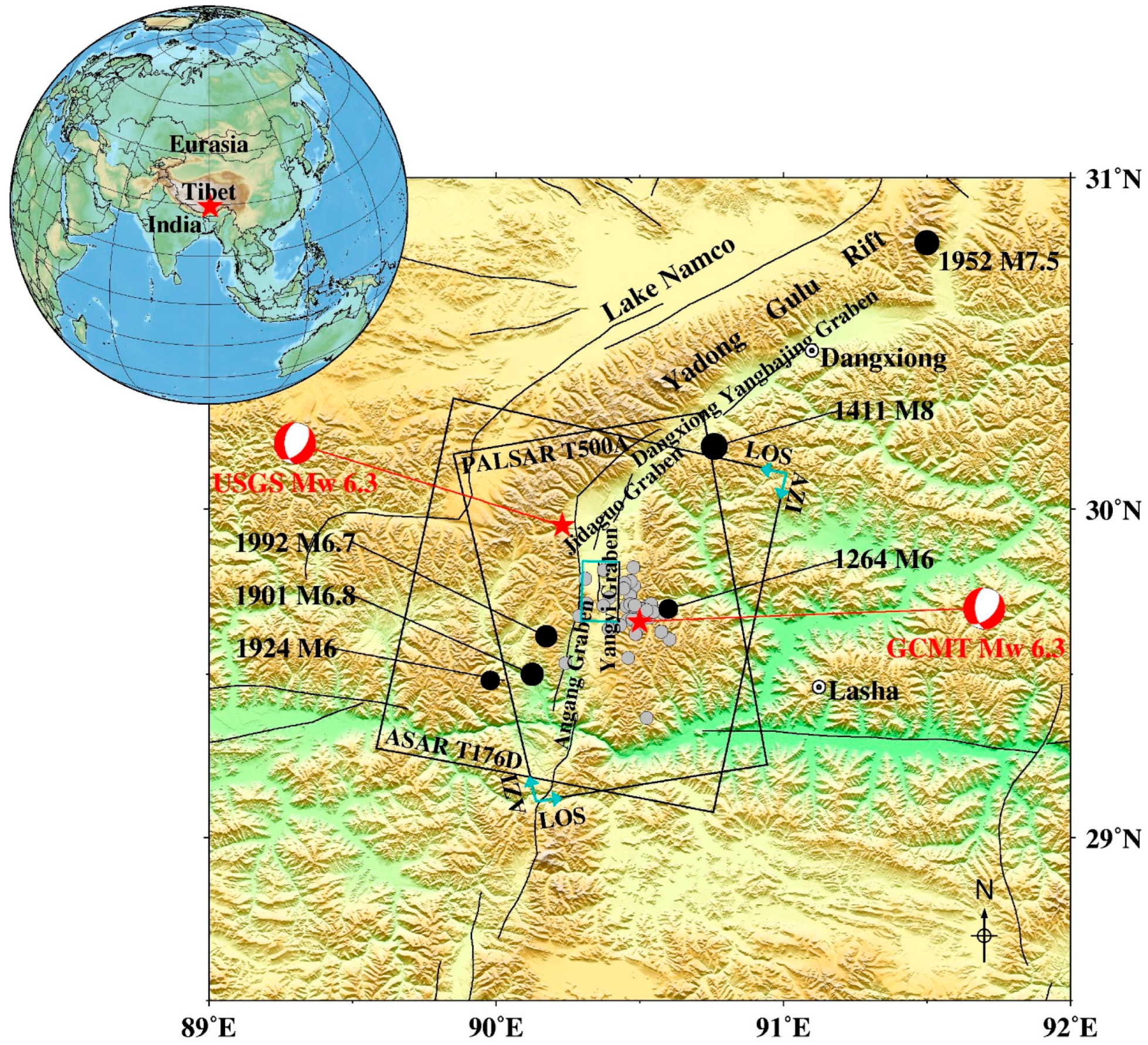


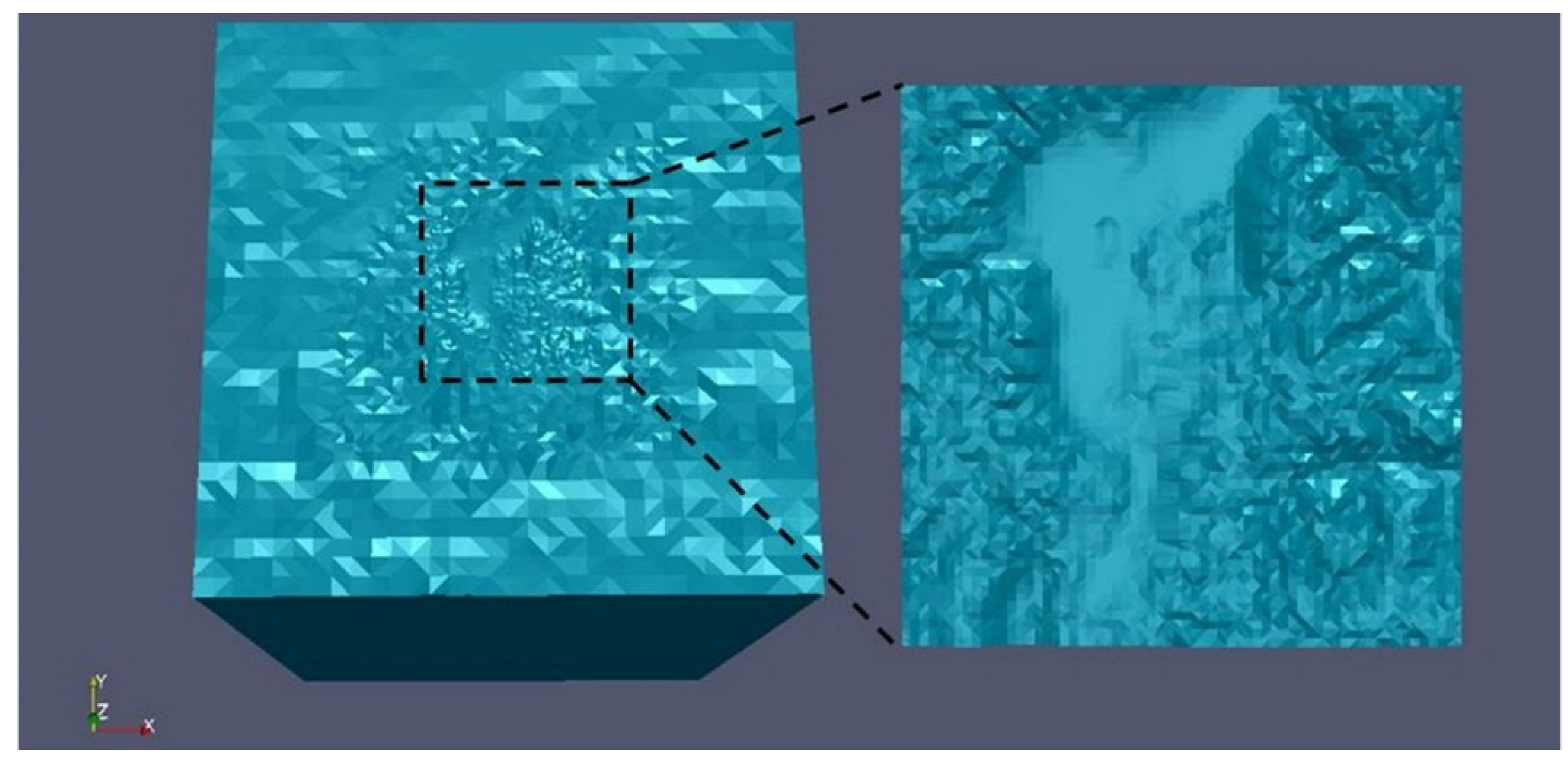


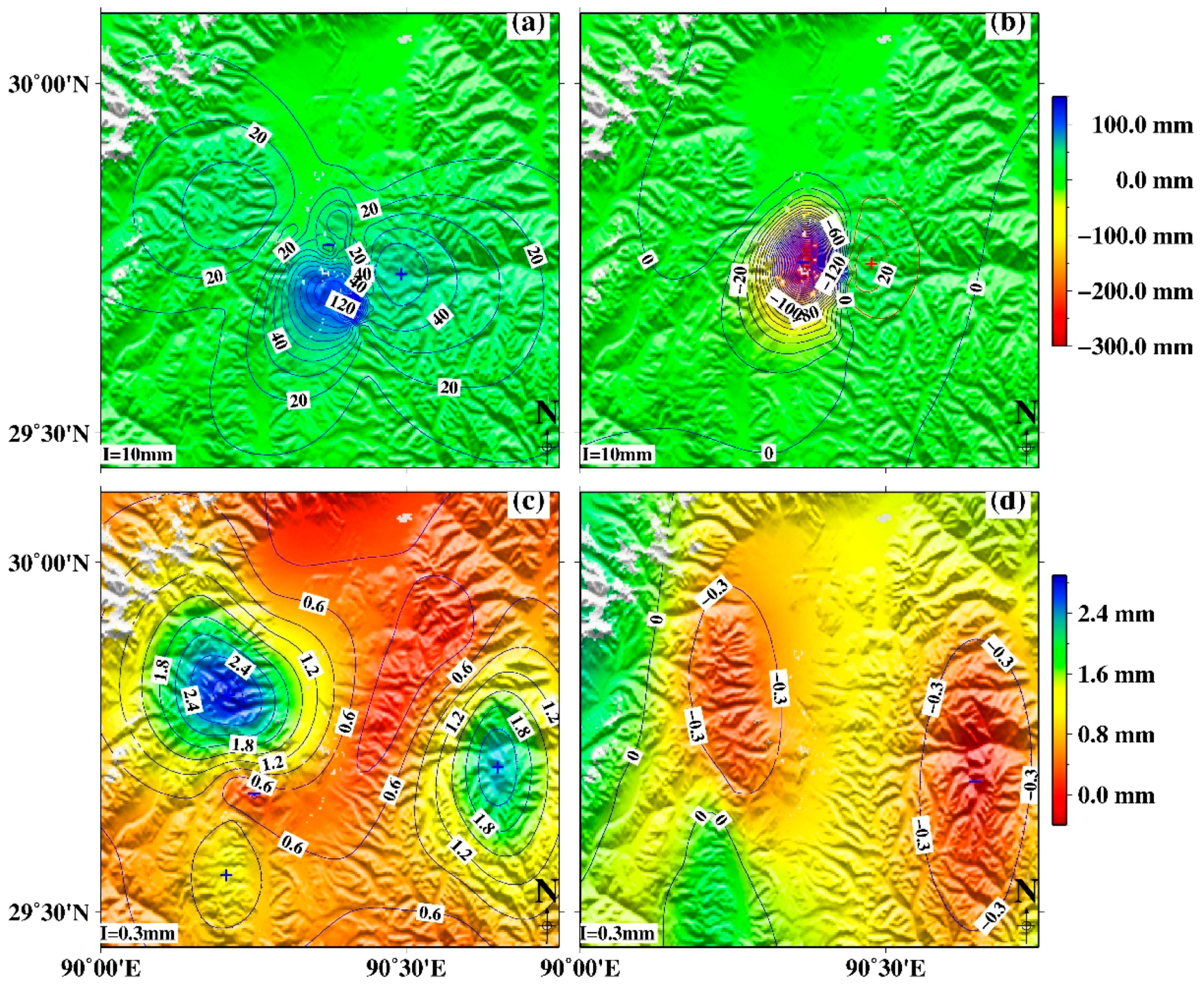
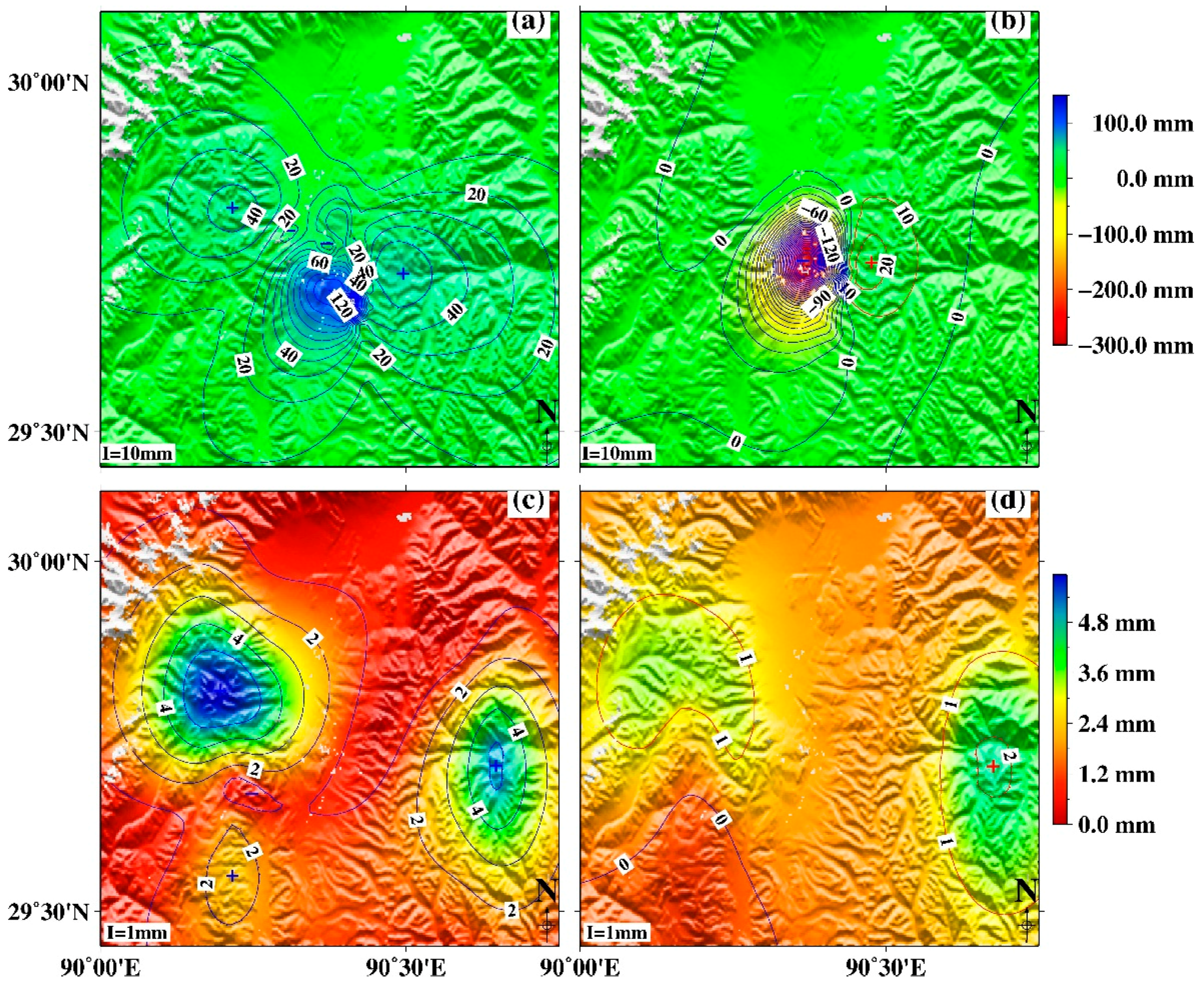
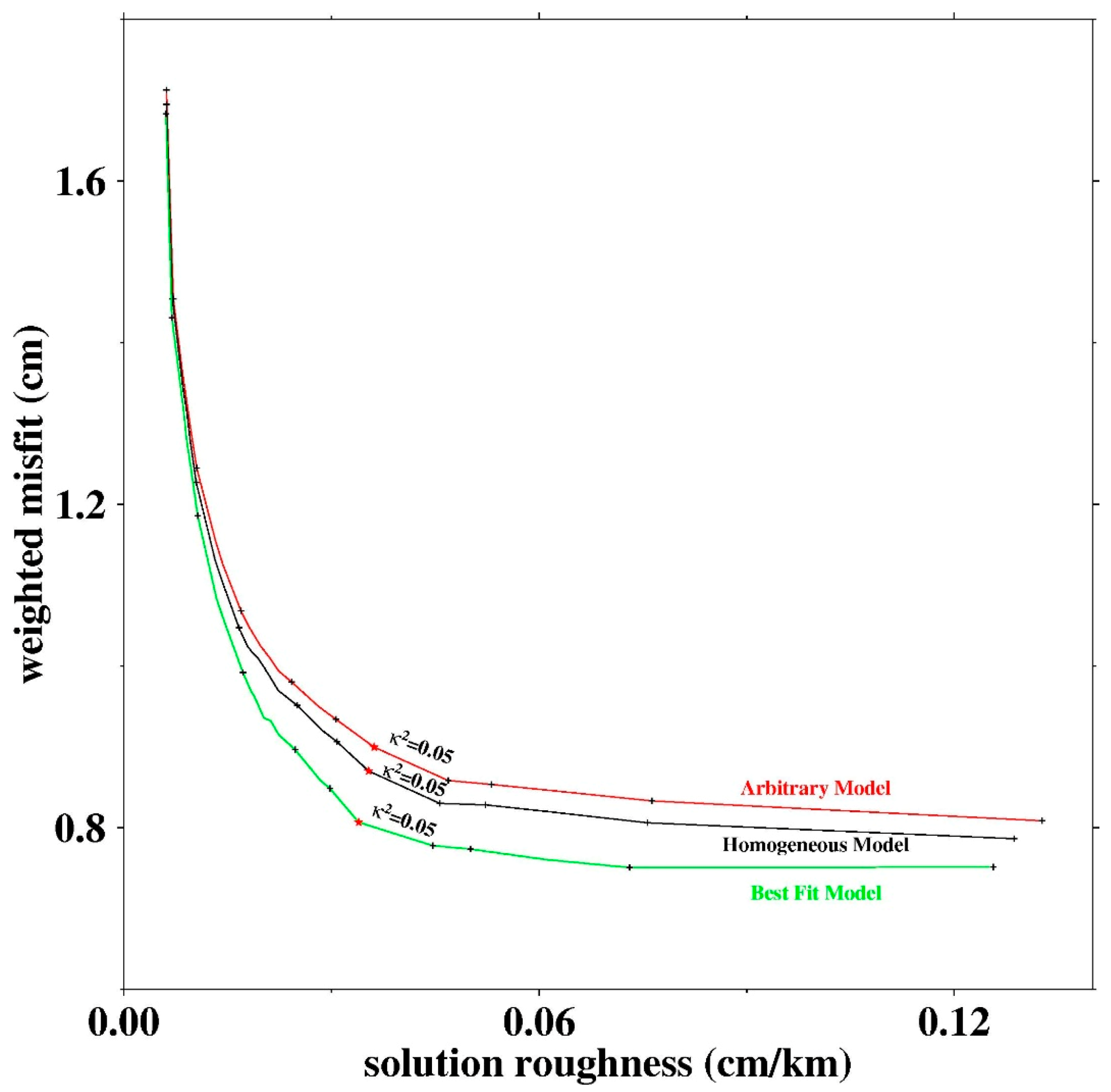
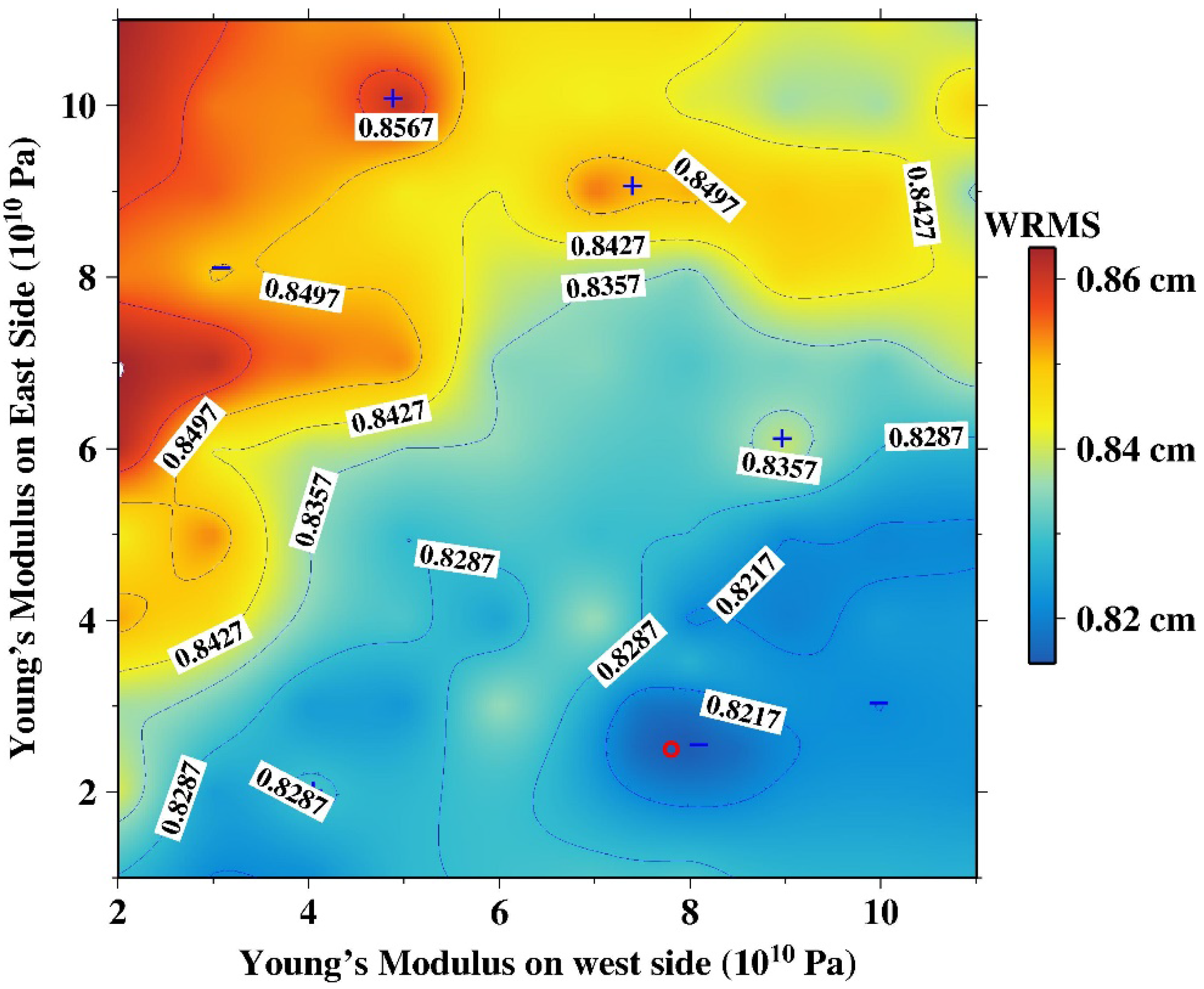

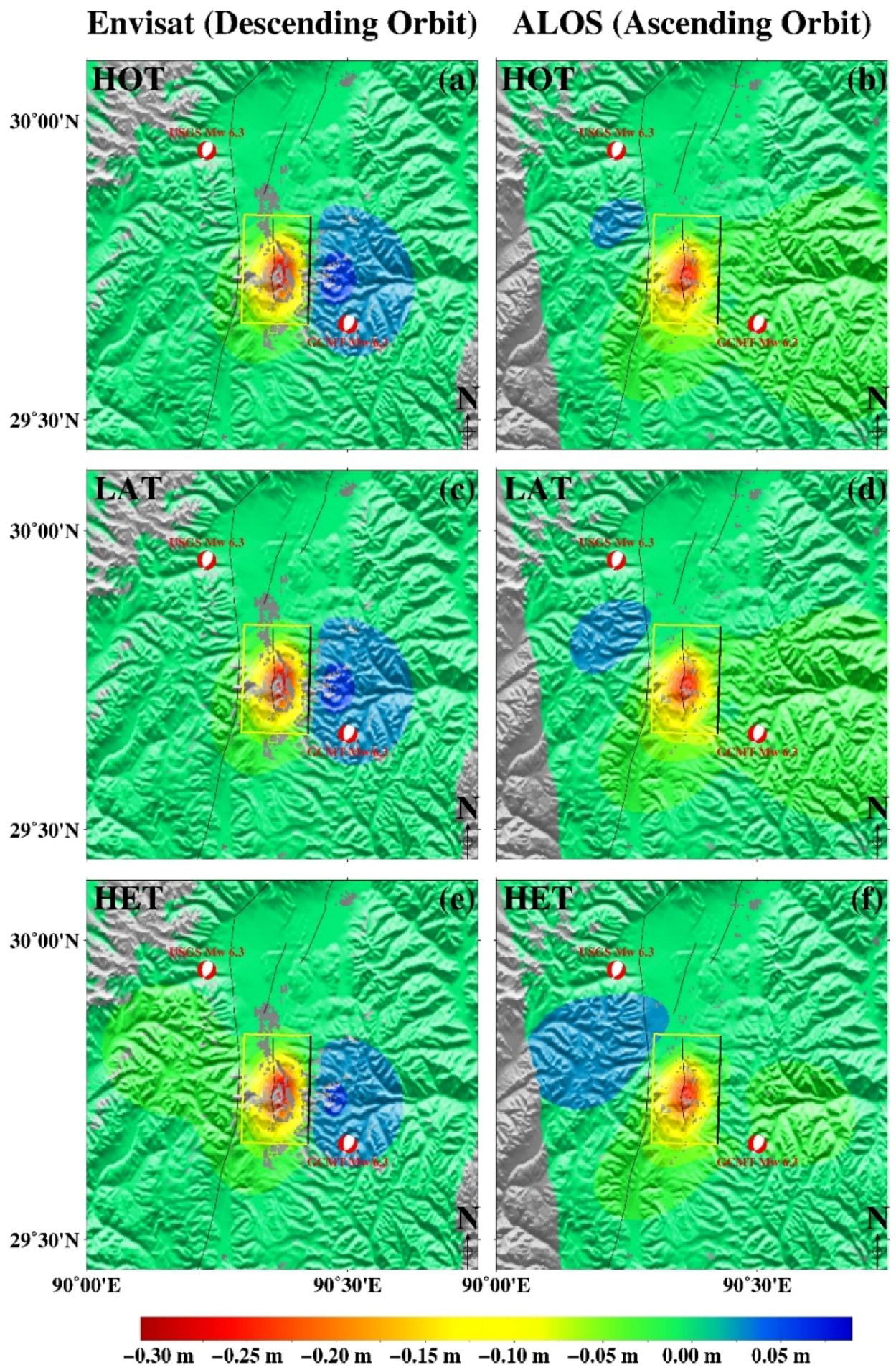
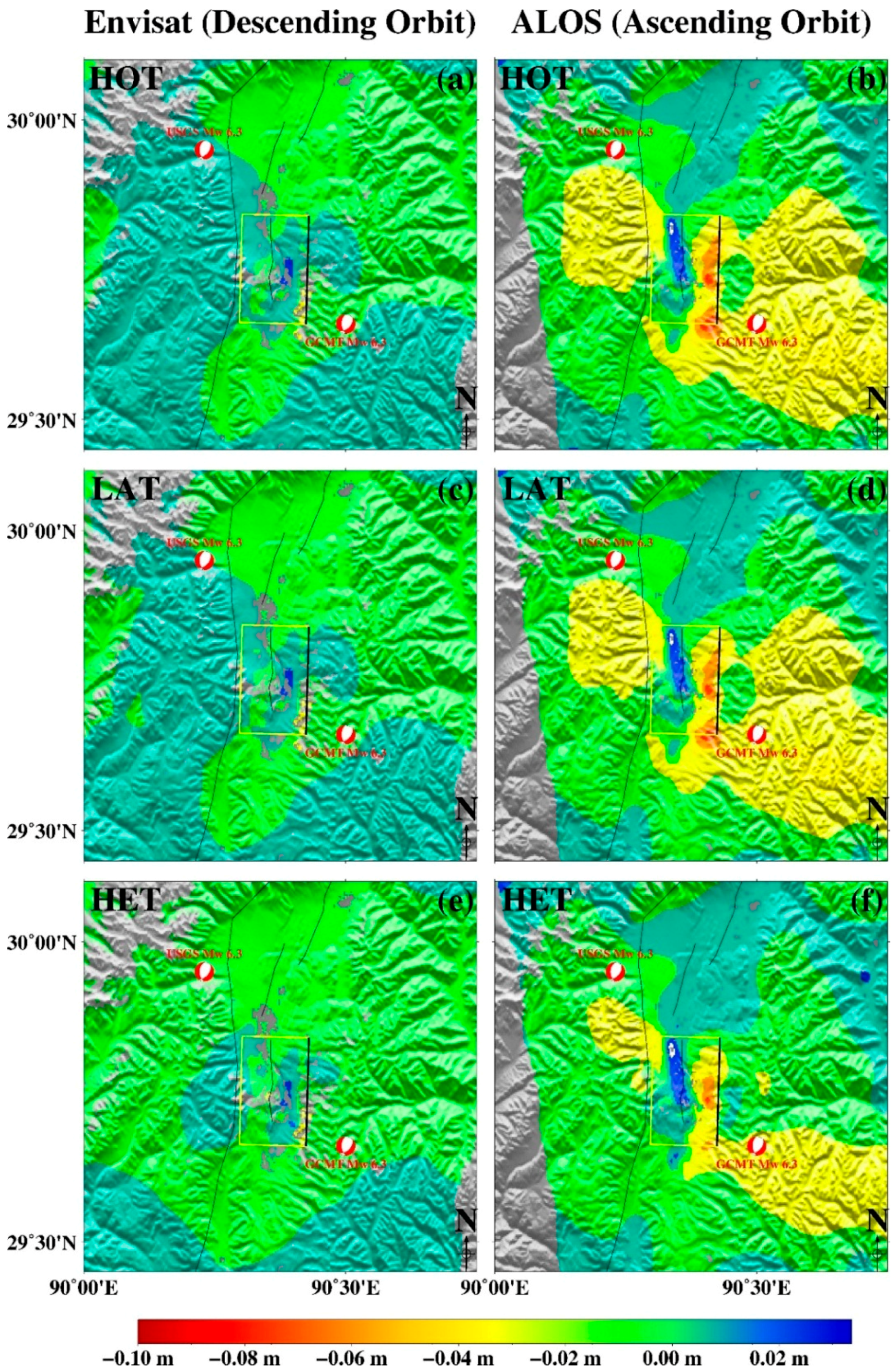

| Satellite | Date1 yymmdd | Date2 yymmdd | Bperp a m | Track (A/D) b | σ c cm | l d km | From |
|---|---|---|---|---|---|---|---|
| Envisat | 070415 | 090419 | 0.47 | 176(D) | 0.43 | 8.6 | Liu et al. [31] |
| ALOS | 070213 | 090821 | −72.5 | 500(A) | 1.53 | 5.3 |
| Strike (°) | Dip (°) | Rake (°) | Slip m | Longitude a (°) | Latitude a (°) | Length km | Width b km | Top c km | From |
|---|---|---|---|---|---|---|---|---|---|
| 182.18 | 54.36 | variable | variable | 90.4267 | 29.7498 | 20 | 20 | 0 | Liu et al. [31] |
| Layers | Thickness km | ρ kg/m3 | Vs m/s | Vp m/s |
|---|---|---|---|---|
| upper crust | 38 | 2720.0 | 3520.0 | 6000.0 |
| middle crust | 18 | 2790.0 | 3680.0 | 6300.0 |
| lower crust | 20 | 2850.0 | 3820.0 | 6600.0 |
© 2016 by the authors; licensee MDPI, Basel, Switzerland. This article is an open access article distributed under the terms and conditions of the Creative Commons by Attribution (CC-BY) license (http://creativecommons.org/licenses/by/4.0/).
Share and Cite
Xu, C.; Xu, B.; Wen, Y.; Liu, Y. Heterogeneous Fault Mechanisms of the 6 October 2008 MW 6.3 Dangxiong (Tibet) Earthquake Using Interferometric Synthetic Aperture Radar Observations. Remote Sens. 2016, 8, 228. https://doi.org/10.3390/rs8030228
Xu C, Xu B, Wen Y, Liu Y. Heterogeneous Fault Mechanisms of the 6 October 2008 MW 6.3 Dangxiong (Tibet) Earthquake Using Interferometric Synthetic Aperture Radar Observations. Remote Sensing. 2016; 8(3):228. https://doi.org/10.3390/rs8030228
Chicago/Turabian StyleXu, Caijun, Bei Xu, Yangmao Wen, and Yang Liu. 2016. "Heterogeneous Fault Mechanisms of the 6 October 2008 MW 6.3 Dangxiong (Tibet) Earthquake Using Interferometric Synthetic Aperture Radar Observations" Remote Sensing 8, no. 3: 228. https://doi.org/10.3390/rs8030228








